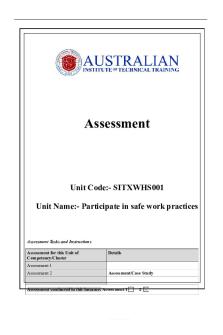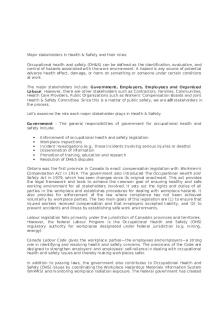Sitxwhs 003 - A01 - Implement and monitor work health and safety practices PDF

| Title | Sitxwhs 003 - A01 - Implement and monitor work health and safety practices |
|---|---|
| Author | Professor Bunny |
| Course | Implement and monitor work health and safety practices |
| Institution | Central Queensland University |
| Pages | 6 |
| File Size | 223.8 KB |
| File Type | |
| Total Downloads | 81 |
| Total Views | 135 |
Summary
Download Sitxwhs 003 - A01 - Implement and monitor work health and safety practices PDF
Description
SIT40516 Certificate IV in Commercial Cookery
SITXWHS003 Implement and monitor work health and safety practices ASSESSMENT 1: Assignment Student’s Name
CHUN CHUIN LIM
Student No
4175
Student Declaration
I declare that the work submitted is my own. It has not been copied or plagiarised from any other person or source.
Student’s Signature
Vince
Date Submitted
12/8/18
1
Part A - Planning WHS systems, consultation and risk assessment 1. You are required to plan the following situations: 1) evacuation of staff and customers 2) security management of cash, documents, equipment, keys or people 3) handling chemicals and hazardous substances 2. Once your situations have been selected, you need to access the relevant codes of practice from the SafeWork NSW website (http://www.safework.nsw.gov.au/). Situation
Evacuation of staff and customers
Security management of cash, documents, equipment, keys or people
Handling chemicals and hazardous substances
Code/legislation/factsheet
Work Health and Safety Regulation 2017 Chapter 3 - General risk and workplace management
Work Health and Safety Regulation 2017 Chapter 6 - Security of workplace
Work Health and Safety Regulation 2017 Chapter 7 - Hazardous chemicals
2
Reference https://www.legislation.nsw.gov .au/#/view/regulation/2017/404 /chap3/part3.2/div4/sec43 http://www.safework.nsw.gov.a u/health-and-safety/manageworkplace-safety/emergencyplans https://www.legislation.nsw.gov .au/#/view/regulation/2017/404 /chap6/part6.3/div1/sec298 http://www.safework.nsw.gov.a u/health-and-safety/manageworkplace-safety/workplacefacilities https://www.legislation.nsw.gov .au/#/view/regulation/2017/404 /chap7 http://www.safework.nsw.gov.a u/health-and-safety/safetytopics-a-z/hazardous-chemical
3. After you have identified the specific requirements for each situation you will need to plan, develop and implement consultation processes with your staff/ colleagues.
1. Instance Situation: Evacuation of staff and customers Describe the legal requirements set out by the relevant code/legislation that applies to this situation A person conducting a business or undertaking at a workplace must ensure that an emergency plan is prepared for the workplace, that provides for the following: (a) Emergency procedures, including: An effective response to an emergency Evacuation procedures Notifying emergency service organisations at the earliest opportunity Medical treatment and assistance Effective communication between the person authorised by the person conducting the business or undertaking to coordinate the emergency response and all persons at the workplace, (b) Testing of the emergency procedures, including the frequency of testing, (c) Information, training and instruction to relevant workers in relation to implementing the emergency procedures. Maximum penalty: (a) In the case of an individual—$6,000, (b) In the case of a body corporate—$30,000. Consultation Requirements: Where, when, what When the emergency happened in the workplace, such as fire, explosion, chemical spill, medical emergency, natural disaster, bomb threat or violence. Who is involved: Employee, staff worker, consumer Risk assessment including Hazard Analysis – what will need to be assessed No-one can predict when an emergency is going to take place. Emergency situations may arise due to a fire, explosion, chemical spill, medical emergency, natural disaster, bomb threat or violence. Making a plans and procedures will help staff in the event of an emergency. Make a emergency plan need to considerate about below: Type of work Safety issues The size and location of your workplace The number of workers Complete the risk assessment template marked “Situation
3
2. Instance Situation: Security management of cash, documents, equipment, keys or people Describe the legal requirements set out by the relevant code/legislation that applies to this situation 1. A person with management or control of a workplace at which construction work is carried out must ensure, so far as is reasonably practicable, that the workplace is secured from unauthorised access. Maximum penalty: (a) in the case of an individual—$3,600, or (b) in the case of a body corporate—$18,000. 2. In complying with subclause (1), the person must have regard to all relevant matters, including: (a) risks to health and safety arising from unauthorised access to the workplace, and (b) the likelihood of unauthorised access occurring, and Consultation Requirements: Where, when, what When a business or undertaking involved in cash handling or transportation activities, the duty holders should share information about the hazards and risks and work together in a co-operative and co-ordinated way to eliminate or minimize the risks so far as is reasonably practicable. Who is involved: Employee, staff worker, Consumer Risk assessment including Hazard Analysis – what will need to be assessed Some factors which can increase the risk robbery and armed hold-ups include: Large amounts of cash stored in the cash registers A safe which is visible to the public The business being located in an area with a high crime rate Complete the risk assessment template marked “Situation
4
3. Instance Situation: Handling chemicals and hazardous substances Describe the legal requirements set out by the relevant code/legislation that applies to this situation Stopping use of underground storage and handling systems 1. This clause applies in relation to a system used at a workplace for the use, handling or storage of hazardous chemicals underground if a person conducting a business or undertaking at the workplace intends that the system no longer be used for the use, handling or storage of the hazardous chemicals or be disposed of. 2. The person must ensure, so far as is reasonably practicable, that the system is removed. Maximum penalty: (a) In the case of an individual—$6,000, In the case of a body corporate—$30,000. 3. If it is not reasonably practicable to remove the system, the person must ensure, so far as is reasonably practicable, that the system is without risks to health and safety. Maximum penalty: (a) in the case of an individual—$6,000, or (b) in the case of a body corporate—$30,000. Consultation Requirements: Where, when, what There are literally thousands of hazardous chemicals used in the workplace – paints, pesticides, cleaners and fuels.. Who is involved: Whoever is using the product Risk assessment including Hazard Analysis – what will need to be assessed Without the proper controls it can cause cancer, respiratory illnesses, skin and eye irritations, and fire and explosion-related injuries. What we need to do as below: Check labels and clean containers Obtain and provide safety information Keep a register and manifest Display placards and signs Prevent contamination of personal items Keep chemicals stable Manage spills and leaks Avoid damage to chemicals Install appropriate fire protection Have emergency equipment and plans Issue safety equipment Have proper storage and handling systems Supervise your workers and check your workers’ health Using prohibited carcinogens and chemicals Managing pipelines Legislation and codes Complete the risk assessment template marked “Situation 5...
Similar Free PDFs

Health and Safety Training
- 8 Pages

health and safety essay
- 4 Pages

Health, Hygiene and Safety
- 28 Pages
Popular Institutions
- Tinajero National High School - Annex
- Politeknik Caltex Riau
- Yokohama City University
- SGT University
- University of Al-Qadisiyah
- Divine Word College of Vigan
- Techniek College Rotterdam
- Universidade de Santiago
- Universiti Teknologi MARA Cawangan Johor Kampus Pasir Gudang
- Poltekkes Kemenkes Yogyakarta
- Baguio City National High School
- Colegio san marcos
- preparatoria uno
- Centro de Bachillerato Tecnológico Industrial y de Servicios No. 107
- Dalian Maritime University
- Quang Trung Secondary School
- Colegio Tecnológico en Informática
- Corporación Regional de Educación Superior
- Grupo CEDVA
- Dar Al Uloom University
- Centro de Estudios Preuniversitarios de la Universidad Nacional de Ingeniería
- 上智大学
- Aakash International School, Nuna Majara
- San Felipe Neri Catholic School
- Kang Chiao International School - New Taipei City
- Misamis Occidental National High School
- Institución Educativa Escuela Normal Juan Ladrilleros
- Kolehiyo ng Pantukan
- Batanes State College
- Instituto Continental
- Sekolah Menengah Kejuruan Kesehatan Kaltara (Tarakan)
- Colegio de La Inmaculada Concepcion - Cebu












